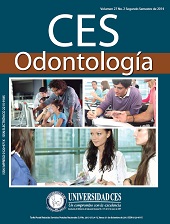Molecular identification and genotyping of Streptococcus mutans from saliva samples of children in Medellin, Colombia
Resumen
Introduction and objective:
Tooth decay is one of the most prevalent infectious diseases of the oral cavity. The aim of this study was to determine the prevalence of Streptoccocus mutans and its genotypes in saliva samples from 6 and 7 year old children with and without dental caries.
Materials and methods:
Forty seven saliva samples were obtained from 6-7 year-old children, randomly selected from a Public School in Medellin, Colombia. Oral examinations in order to determine the DMF-T Index (Decay, Missing and Filling Teeth) were carried out. Isolates were identified by the Streptoccocus sobrinus and Streptococcus mutans PCR, API 20STREP and 16S rRNA sequence analysis. Genotypes c, e, f and k were detected by PCR.
Results:
Prevalence of S. mutans was 14.9%. Of the 47 saliva samples, 57.4% (27) corresponded to children with dental caries, and 8.5% (4) were positive for S. mutans genotype c, 2.1% (1 each) genotype f, genotype k, and genotype c and k, respectively.
Conclusion:
Prevalence of S. mutans was lower than in previous studies of Colombian children with similar demographic characteristics. Streptoccocus mutans genotype c, f and k were found in children with caries but not in the group without caries. This is the first report of S. mutans genotype k in Colombia; this genotype requires further study to clarify its relation with dental caries and cardiovascular disease in Colombia.
Descargas
Referencias bibliográficas
grupo mutans, según edad, evaluado en saliva por un método semi-cuantitativo. Rev Chil Infect.
2011;28(3):230-237.
2. Gutiérrez S. Microorganismos cariogénicos. En: Fundamentos de ciencias básicas aplicadas a la
odontología. 1 ed. Bogotá: Pontificia Universidad Javeriana; 2006. p. 16 - 21.
3. Gamboa F, Herazo B, Martínez M. Control microbiológico sobre Streptococcus mutans y su acción
acidogénica. Universitas Scientiarum 2004;9:45-55.
4. Figueroa M, Alonso G, Acevedo A. Microorganismos presentes en las diferentes etapas de la progresión
de la lesión de caries dental. Acta Odontol Venez. 2009;47(1):1-13.
5. Reyes B, Martín J, Yevenes I, Neira M, Palma P, Gordan V, et al. Activity and efects of urease and
argnine deaminase in saliva and human oral biofilm. Rev Fac Odontol Univ Antioq. 2012;23(2):343- 352.
6. Forssten S, Bjorklund M, Ouwehand A. Streptococcus mutans, caries and simulation models. Nutrients.
2010;2(3):290-298.
7. Ikeda T, Ochiai K, Shiota T. Taxonomy of the oral Streptococcus mutans based on colonial characteristics
and serological, biochemical and genetic features. Arch Oral Biol. 1979;24(10-11):863-867.
8. Burne R. Oral streptococci Products of their environment. J Dent Res. 1998;77(3):445–452.
9. Koo H, Xiao J, Klein M, Jeon J. Exopolysaccharides produced by Streptococcus mutans
glucosyltransferases modulate the establishment of microcolonies within multispecies biofilms. J Bacteriol.
2010;192(12):3024–3032.
10. Busuioc M, Mackiewicz K, Buttaro B, Piggot P. Role of intracellular polysaccharide in persistence of
Streptococcus mutans. J Bacteriol. 2009;191(23):7315–7322.
11. Sánchez L, Acosta E. Estreptococos cariogénicos predominantes, niveles de infección e incidencia de
caries en un grupo de escolares. Estudio exploratorio. Rev ADM 2007;LXIV(2):45 - 51.
12. Nakano K, Nomura R, Nakagawa I, Hamada S, Ooshima T. Demonstration of Streptococcus mutans
with a cell wall polysaccharide specific to a new serotype k, in the human oral cavity. J Clin Microbiol.
2004 Jan;42(1):198-202.
13. Nakano K, Nomura R, Shimizu N, Nakagawa I, Hamada S, Ooshima T. Development of a PCR method
for rapid identification of new Streptococcus mutans serotype k strains. J Clin Microbiol. 2004;42(11):4925-
4930.
14. Huang X, Liu T, Cai Z, Chen Z, Yang J, Liu J. [Evaluation of the in vitro cariogenic potential of
Streptococcus mutans (serotype c) strains isolated from caries-free and -active people: the ability of
acidogenicity]. Sichuan Da Xue Xue Bao Yi Xue Ban. 2004;35(4):520-521.
15. Hui-qing F, Bu-ling W, Ling-yun S, et al. Evaluation of the acidogenicity of Streptococcus Mutans
(serotype c) isolates of the elderly people with caries. Chinese journal of conservative dentistry. 2006(1):21-
23.
16. Martin M, Longman L, Forde M, Butterworth M. Infective endocarditis and dentistry: the legal basis
for an association. Br Dent J. 2007;203(1):38-39.
17. Nakano K, Nemoto H, Nomura R, Homma H, Yoshioka H, Shudo Y, et al. Serotype distribution of
Streptococcus mutans a pathogen of dental caries in cardiovascular specimens from Japanese patients.
J Med Microbiol. 2007;56:551-556.
18. Nakano K., Nomura R., Ooshima T. Streptococcus mutans and cardiovascular diseases. Japanese
Dental Science Review. 2008;44:29-37.
19. Nakano K, Nomura R, Matsumoto M, Ooshima T. Roles of oral bacteria in cardiovascular diseasesfrom
molecular mechanisms to clinical cases: Cell-surface structures of novel serotype k Streptococcus
mutans strains and their correlation to virulence. J Pharmacol Sci. 2010;113(2):120-125.
20. Nakano K, Nomura R, Nemoto H, Mukai T, Yoshioka H, Shudo Y, et al. Detection of novel serotype
k Streptococcus mutans in infective endocarditis patients. J Med Microbiol. 2007;56(Pt 10):1413-1415.
21. Gamboa F, Galindo A, Estupiñan M. Presence of Streptococcus mutans in saliva and its relationship
with dental caries: antimicrobial susceptibility of the isolates. Universitas Scientiarum. 2004;9:23-27.
22. Thomson L, Little W, Bowen W, Sierra L, Aguirrer M, Gillespie G. Prevalence of Streptococcus mutans
Serotypes, Actinomyces, and Other Bacteria in the Plaque of Children. J Dent Res 1980;59(10):1581 - 89.
23. Coykendall A. Proposal to elevate the subspecies of Streptococcus mutans to species status, based
on their molecular composition. Int J Sys Bacteriol. 1977;27(1):26 -30.
24. Oho T, Yamashita Y, Shimazaki Y, Kushiyama M, Koga T. Simple and rapid detection of Streptococcus
mutans and Streptococcus sobrinus in human saliva by polymerase chain reaction. Oral Microbiol
Immunol. 2000;15:258–262.
25. Ye J, Coulouris G, Zaretskaya I, Cutcutache I, Rozen S, Madden T. Primer-BLAST: a tool to design
target-specific primers for polymerase chain reaction. BMC Bioinformatics. 2012;13:134.
26. Spradbery P. Restriction fragment length polymorphisms of mutans streptococci in forensic
odontological analysis. Biosciencehorizons. 2010;3(2):166 - 178.
27. Matsuyama J, Sato T, Washio J, Mayanagi G, Ito Y, Abiko Y, et al. PCR for detection of mutans
streptococci in human dental plaque. International Congress Series. 2005;1284:158–162.
28. Dunbar J, Ticknor L, Kuske C. Phylogenetic specificity and reproducibility and new method for analysis
of terminal restriction fragment profiles of 16S rRNA genes from bacterial communities. Appl Environ
Microbiol. 2001;67(1):190-197.
29. Altschul S, Gish W, Miller W, Myers E, Lipman D. Basic local alignment search tool. J Mol Biol.
1990;215(3):403-410.
30. Shibata Y, Ozaki K, Seki M, Kawato T, Tanaka H, Nakano Y, et al. Analysis of loci required for
determination of serotype antigenicity in Streptococcus mutans and its clinical utilization. J Clin Microbiol.
2003; 41(9):4107-4112.
31. Franco A, Ochoa E, Ramírez B, Segura A, Tamayo A, García C. Situación de salud bucal de los
escolares de Medellín. VI monitoreo. Año 2006. 2007;2(1):57-69.
32. Petersen P. The World Oral Health Report 2003: continuous improvement of oral health in the 21st
century the approach of the WHO Global Oral Health Programme. Community Dent Oral Epidemiol.
2003;31(Suppl 1):3-23.
33. Taku Y, Kasuko T. Distribution and Characterization of Serotype k Streptococcus mutans. Int J Oral-
Med Sci. 2011;10(2):89-95.
34. Kanasi E, Johansson I, Lu S, Kressin N, Nunn M, Kent R, et al. Microbial risk markers for childhood
caries in pediatricians' offices. J Dent Res. 2010;89(4):378-383.
35. Okada M, Soda Y, Hayashi F, Doi T, Suzuki J, Miura K, et al. Longitudinal study of dental caries
incidence associated with Streptococcus mutans and Streptococcus sobrinus in pre-school children. J
Med Microbiol. 2005;54:661–665.
36. Klein H, Palmer C., Knutson J. Studies on Dental Caries, I, Dental status and Dental Needs of elementary
school. Pub Health Rep. 1938;53:751-765.
37. Saldarriaga A, Arango C, Cossio M. Dental caries in the primary dentition of a Colombian population
according to the ICDAS criteria. Braz Oral Res. 2010;24(2):211-216.
38. Escobar G, Ramírez B, Franco A, Tamayo A, Castro J. Experiencia de caries dental en niños de 1- 5
años de bajos ingresos. Medellín, Colombia. Rev CES Odont. 2009;22(1):21-28.
39. Frazão P. Epidemiology of dental caries: when structure and context matter. Braz Oral Res.
2012;26(Spec Iss 1):108-114.
40. Truong T, Menard C, Mouton C, Trahan L. Identification of mutans and other oral streptococci by
random amplified polymorphic DNA analysis. J Med Microbiol. 2000;49(1):63-71.
41. Lal D, Verma M., Lal R. Exploring internal features of 16S rRNA gene for identification of clinically
relevant species of the genus Streptococcus. Ann Clin Microbiol Antimicrob. 2011;10:28.
42. Bosshard P, Abels S, Altwegg M, Bottger E, Zbinden R. Comparison of conventional and molecular
methods for identification of aerobic catalase-negative gram-positive cocci in the clinical laboratory. J Clin
Microbiol. 2004;42(5):2065-2073.
43. Ahn J, Yang L, Paster B, Ganly I, Morris L, Pei Z, et al. Oral microbiome profiles: 16S rRNA
pyrosequencing and microarray assay comparison. PLoS One. 2011;6(7):e22788.
44. Zhou Q, Qin X, Qin M, GE L. Genotypic diversity of Streptococcus mutans and Streptococcus sobrinus
in 3–4-year-old children with severe caries or without caries. Int J Paediatr Dent. 2011;21(6):422–431.
45. Biswas S, Biswas I. Complete genome sequence of Streptococcus mutans GS-5, a serotype c strain.
J Bacteriol. 2012 Sep;194(17):4787-4788.
46. Lapirattanakul J, Nakano K, Nomura R, Nemoto H, Kojima A, Senawongse P, et al. Detection of
serotype k Streptococcus mutans in Thai subjects. Oral Microbiol Immunol. 2009;24(5):431-433.
47. Espinosa L, Martínez G, Martínez R, Loyola J, Patiño N, Reyes J, et al. Antimicrobial sensibility of
Streptococcus mutans serotypes to silver nanoparticles. Mater Sci Eng C Mater Biol Appl. 2012;32:896-901.
48. Tsuda H, Yamashita Y, Toyoshima K, Yamaguchi N, Oho T, Nakano Y, et al. Role of serotype-specific
polysaccharide in the resistance of Streptococcus mutans to phagocytosis by human polymorphonuclear
leukocytes. Infect Immun. 2000;68(2):644–650.
49. Nakano K, Hokamura K, Taniguchi N, Wada K, Kudo C, Nomura R, et al. The collagen-binding protein
of Streptococcus mutans is involved in haemorrhagic stroke. Nat Commun. 2011;2(485).
Descargas
Publicado
Cómo citar
Número
Sección
| Estadísticas de artículo | |
|---|---|
| Vistas de resúmenes | |
| Vistas de PDF | |
| Descargas de PDF | |
| Vistas de HTML | |
| Otras vistas | |



